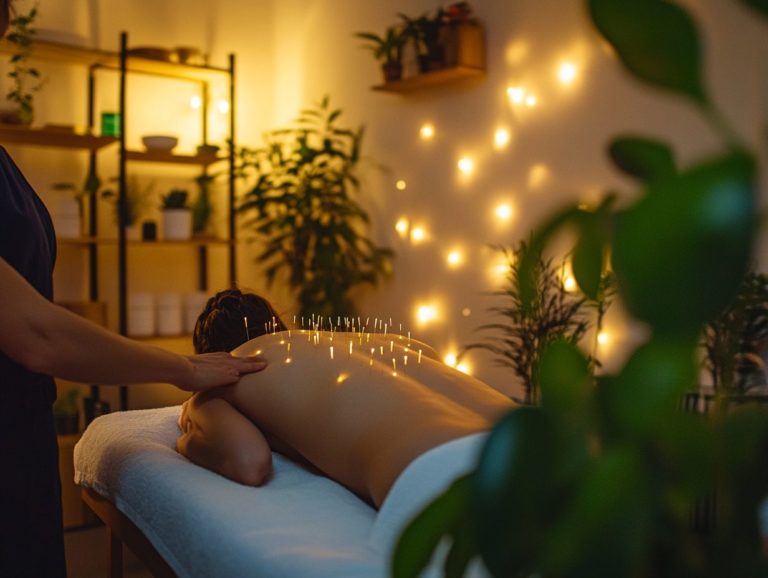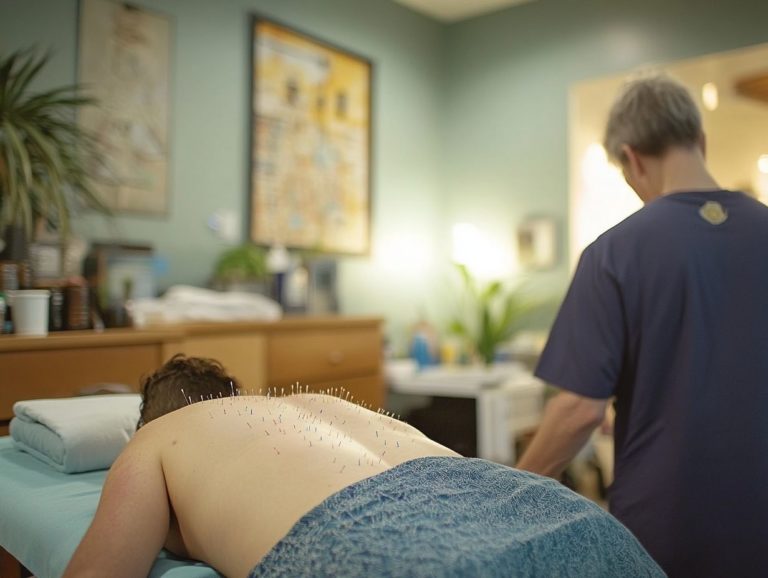The Importance of Proper Acupuncture Needle Techniques
Acupuncture, an ancient practice steeped in the wisdom of Traditional Chinese Medicine, employs fine needles to stimulate specific points on the body, facilitating healing and restoring balance.
The success of this treatment hinges on the precise application of needle techniques. This article delves into the importance of proper needle placement, showcasing various techniques from both traditional and contemporary viewpoints. Choosing a qualified acupuncturist can significantly enhance your experience.
Join us to unlock the benefits of mastering acupuncture needle techniques and achieve optimal health!
Contents
- Key Takeaways:
- Understanding Acupuncture Needle Techniques
- The Importance of Proper Technique
- Different Types of Acupuncture Needle Techniques
- Choosing a Qualified Acupuncturist
- Benefits of Proper Acupuncture Needle Techniques
- Frequently Asked Questions
- What is the importance of using proper acupuncture needle techniques?
- How does proper needle technique affect the patient’s experience?
- What are the consequences of using improper needle techniques?
- Are there different needle techniques for different conditions?
- What should be considered when choosing an acupuncturist?
- Can I learn proper needle techniques for at-home acupuncture?
Key Takeaways:
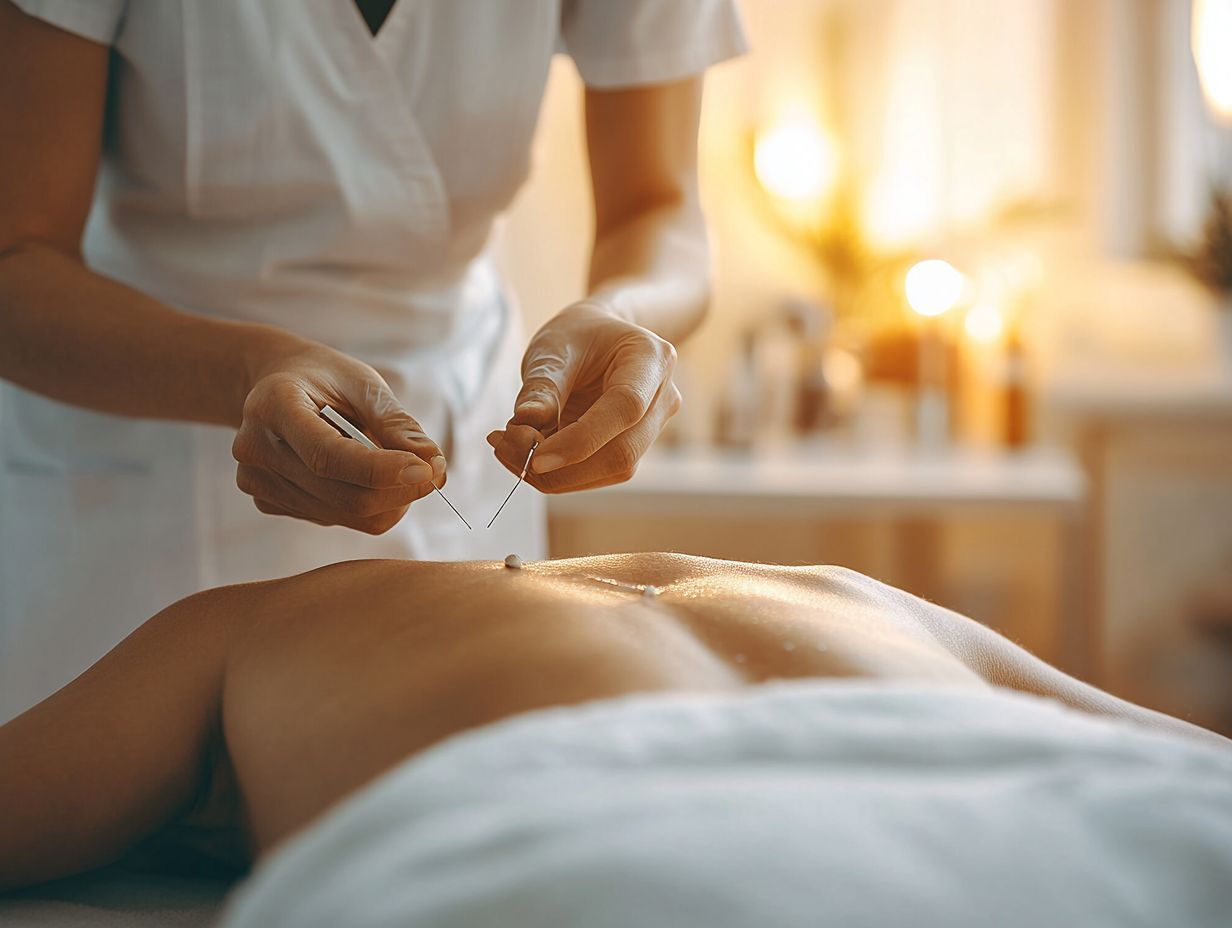
Proper technique is crucial for successful acupuncture treatment. It involves precise needle placement and minimizing discomfort and risks. Both traditional Chinese and modern Western techniques are effective in their own ways. Choosing a qualified acupuncturist with credentials and experience is key for optimal results. When acupuncture needle techniques are performed correctly, it can maximize treatment effectiveness and provide numerous benefits for overall health and well-being.
Understanding Acupuncture Needle Techniques
Understanding acupuncture needle techniques is crucial for you, whether you’re a practitioner or a patient. These techniques play a pivotal role in determining treatment outcomes within traditional Chinese medicine.
By employing acupuncture needles with precision, you can effectively target specific acupuncture points in the body. This enhances energy flow, provides relief from discomfort, and promotes overall wellness.
Prioritizing patient comfort allows each session to be customized to address a variety of health conditions. This includes chronic pain, digestive issues, and emotional balance, creating a truly holistic approach to pain management.
What is Acupuncture?
Acupuncture stands out as a cornerstone of traditional Chinese medicine. Fine needles are artfully inserted into specific points on your body to regulate energy flow and foster healing.
This ancient practice is rooted in the belief that life force (Qi) flows through energy pathways within you. By stimulating these strategic points, acupuncture therapy seeks to restore balance and harmony, addressing not only your physical ailments but also your emotional and mental well-being.
Its versatility is impressive, with applications ranging from alleviating chronic pain and migraines to supporting digestive health and enhancing your overall wellness.
Many have embraced this holistic approach, discovering relief when conventional treatments have missed the mark. This solidifies acupuncture’s vital role in modern healthcare.
The Importance of Proper Technique
The significance of proper technique in acupuncture is paramount, as it directly influences the effectiveness of the treatment and the comfort of the patient throughout each session.
Accomplished acupuncture practitioners employ meticulous needle manipulation and strategic placement of needles to stimulate specific acupuncture points. This precision can result in enhanced outcomes for pain management, relief from anxiety, and overall health optimization.
Effective Needle Placement
Effective needle placement is crucial to your acupuncture treatment. It directly influences the stimulation of acupuncture points and the overall success of the therapy.
As a skilled practitioner, you recognize that the precise location of each needle can significantly enhance the flow of energy, or Qi, throughout your body.
A deep understanding of anatomy and the unique characteristics of various acupuncture points enables you to navigate the intricate networks of energy pathways with finesse.
Your decision-making process involves carefully assessing your specific condition, both physically and emotionally. This allows you to tailor the treatment to your unique needs.
Your hands-on experience is vital in determining the appropriate needle depth and angle. This ensures maximum efficacy while prioritizing your comfort.
This comprehensive approach beautifully showcases the art and science behind this ancient healing practice, elevating your experience to a truly transformative journey.
Minimizing Discomfort and Risks
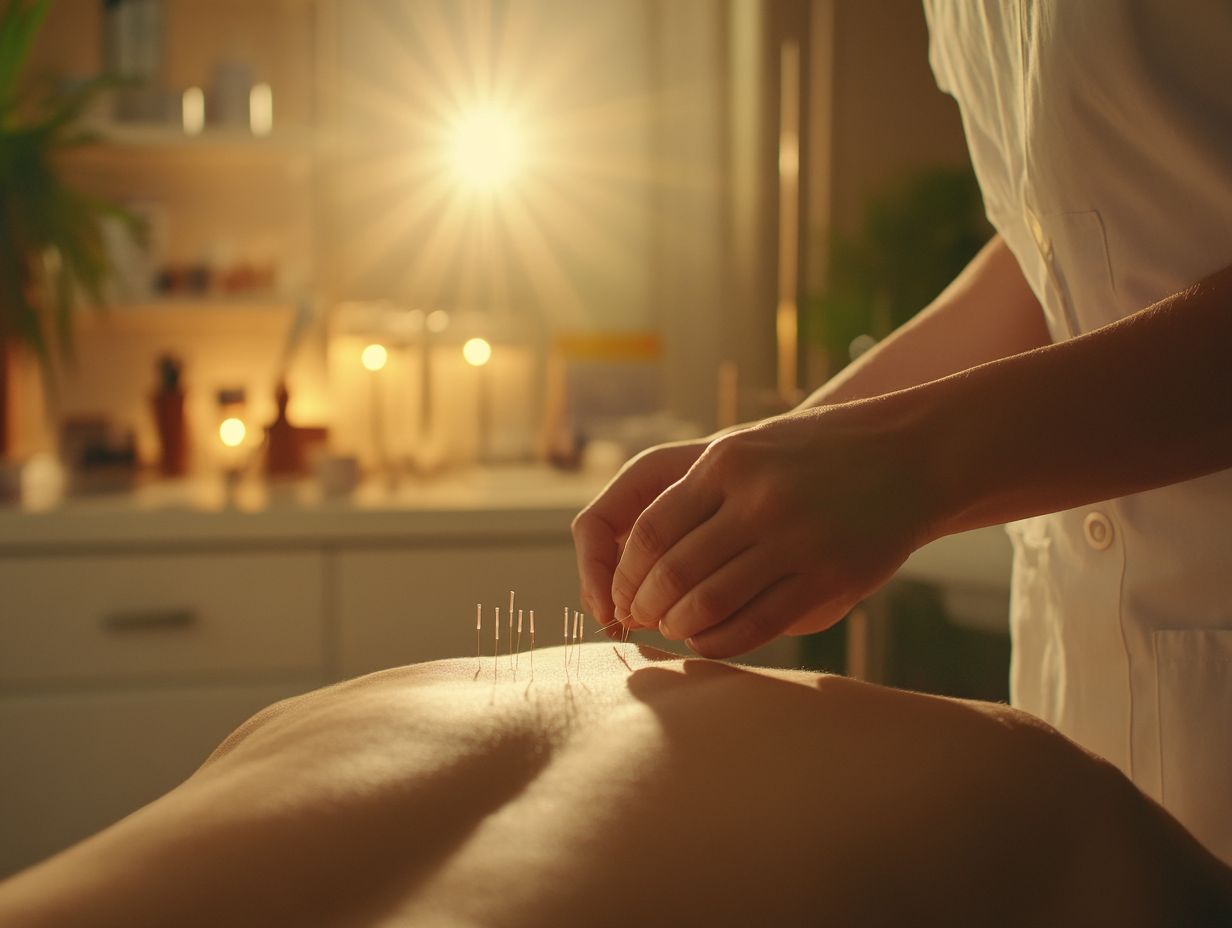
Minimizing discomfort and risks during your acupuncture sessions is essential for enhancing your comfort and ensuring a positive experience with this therapy.
Practitioners can employ several effective strategies that cater specifically to your needs. This includes selecting the right acupuncture needles, which come in various sizes and designs to match your individual pain threshold.
Creating a calming environment and offering clear communication about the procedure can significantly reduce any anxiety you might feel.
Utilizing gentle insertion techniques can further help in minimizing discomfort.
Being aware of potential risks, like bruising or infection, allows practitioners to take proactive measures to maintain safety during your sessions.
Ultimately, prioritizing your comfort fosters trust and encourages a deeper healing experience. This makes your acupuncture journey beneficial for you and everyone involved.
Different Types of Acupuncture Needle Techniques
You ll discover an array of acupuncture needle techniques, each rooted in the rich traditions of Chinese medicine as well as contemporary practices.
These techniques are designed to deliver a wide range of benefits while addressing the unique needs of each patient.
Traditional Chinese Medicine Techniques
Traditional Chinese medicine techniques, particularly acupuncture, focus on restoring balance within your body by addressing the flow of energy through energy pathways and stimulating specific acupuncture points.
These pathways serve as vital conduits that transport essential energy, or Qi, which is the vital energy in the body, throughout your system.
When blockages or imbalances occur within these channels, acupuncture seeks to alleviate pain and enhance your overall well-being by carefully inserting thin needles at designated points.
This holistic practice not only targets physical ailments but also considers your emotional and mental health. It emphasizes a comprehensive approach to healing.
By harmonizing your body s energy, you can feel a boost in your energy and a renewed sense of balance. This highlights the profound philosophies that underpin this ancient medical art.
Modern Western Techniques
Modern Western techniques in acupuncture place a strong emphasis on evidence-based practices, focusing on specific health conditions like chronic pain and pain related to muscles and their surrounding tissues.
This approach beautifully complements traditional methods, offering a refined pathway to healing.
Practitioners fine-tune contemporary techniques through extensive research, integrating modalities such as dry needling and electrical stimulation alongside acupuncture to elevate therapeutic outcomes.
For example, utilizing ultrasound imaging in tandem with acupuncture points can optimize needle placement, significantly enhancing pain relief efficacy.
Clinics are now embracing multidisciplinary strategies, combining acupuncture with physical therapy and psychological support. This creates a holistic treatment landscape that not only targets symptoms but also promotes overall well-being.
Such innovative applications have received positive feedback from patients seeking relief from various conditions, underscoring the versatility and effectiveness of modern acupuncture practices.
Choosing a Qualified Acupuncturist
Don’t wait! Selecting a skilled acupuncturist is crucial for your health and well-being. It is paramount for ensuring both safety and effectiveness in your treatment.
The practitioner’s credentials and experience play a significant role in shaping the outcomes of your sessions.
Making an informed choice will enhance your overall experience and results.
Credentials and Experience
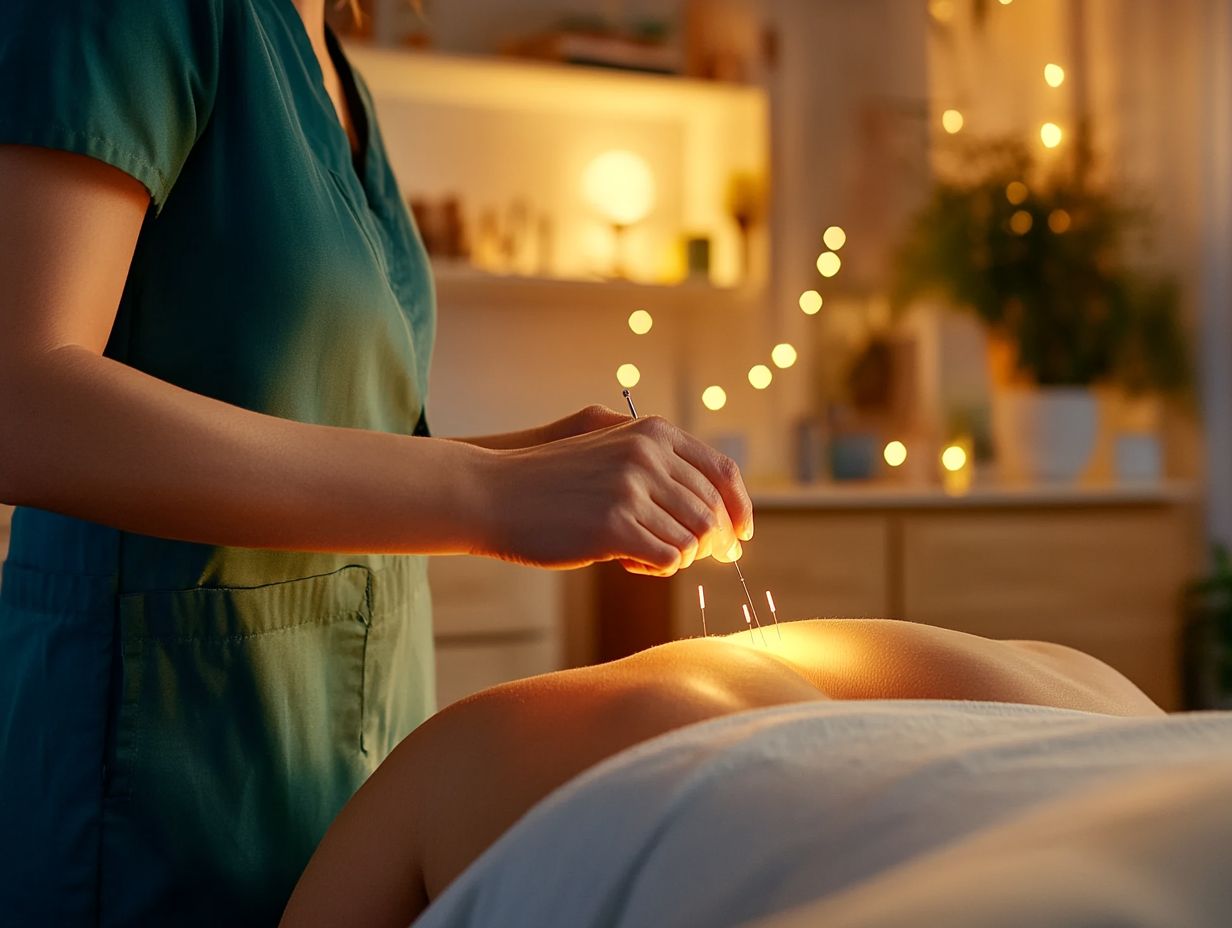
When evaluating potential acupuncture practitioners, understanding their credentials and experience is essential for ensuring a safe and effective therapy experience.
A reputable acupuncturist typically holds a degree from an accredited institution, focusing on Traditional Chinese Medicine or acupuncture.
Certification from recognized boards, such as the National Certification Commission for Acupuncture and Oriental Medicine (NCCAOM), provides added reassurance of their expertise.
Practical experience is crucial. Practitioners should complete a significant number of supervised hands-on hours to refine their skills.
It’s also beneficial for practitioners to engage in continuing education to stay updated on the latest techniques and research. This commitment can significantly elevate the quality of care they provide.
Questions to Ask Before Treatment
Before starting your acupuncture journey, it’s vital to ask the right questions to feel confident and at ease.
- Ask about the techniques used.
- Inquire about the typical number of sessions.
- Discuss the specific symptoms being addressed.
- Gain clarity on the expected outcomes, including how long it might take to notice improvements.
- Don t hesitate to discuss the qualifications and experience of the acupuncturist.
Arriving prepared with these questions will lead to a more satisfying and beneficial experience.
Benefits of Proper Acupuncture Needle Techniques
The advantages of employing proper acupuncture needle techniques go far beyond pain relief. You can experience enhanced treatment effectiveness, emotional balance, and a profound sense of overall wellness as you explore holistic approaches to health.
Maximizing Treatment Effectiveness
Maximizing treatment effectiveness in acupuncture relies on skilled needle manipulation. Strategically placing needles enhances energy flow in your body.
Practitioners can use various needle techniques lifting, thrusting, and rotating to stimulate specific points effectively. These methods encourage a dynamic flow of Qi (pronounced chee ), facilitating pain relief and deeper healing responses.
For example, precise insertion angles create unique resonances, allowing adjustments based on individual needs. A solid understanding of the meridian pathways enhances treatment accuracy, amplifying positive outcomes.
Every session presents an opportunity to fine-tune the approach, making each interaction uniquely tailored to optimize energy flow and overall satisfaction.
Frequently Asked Questions
What is the importance of using proper acupuncture needle techniques?
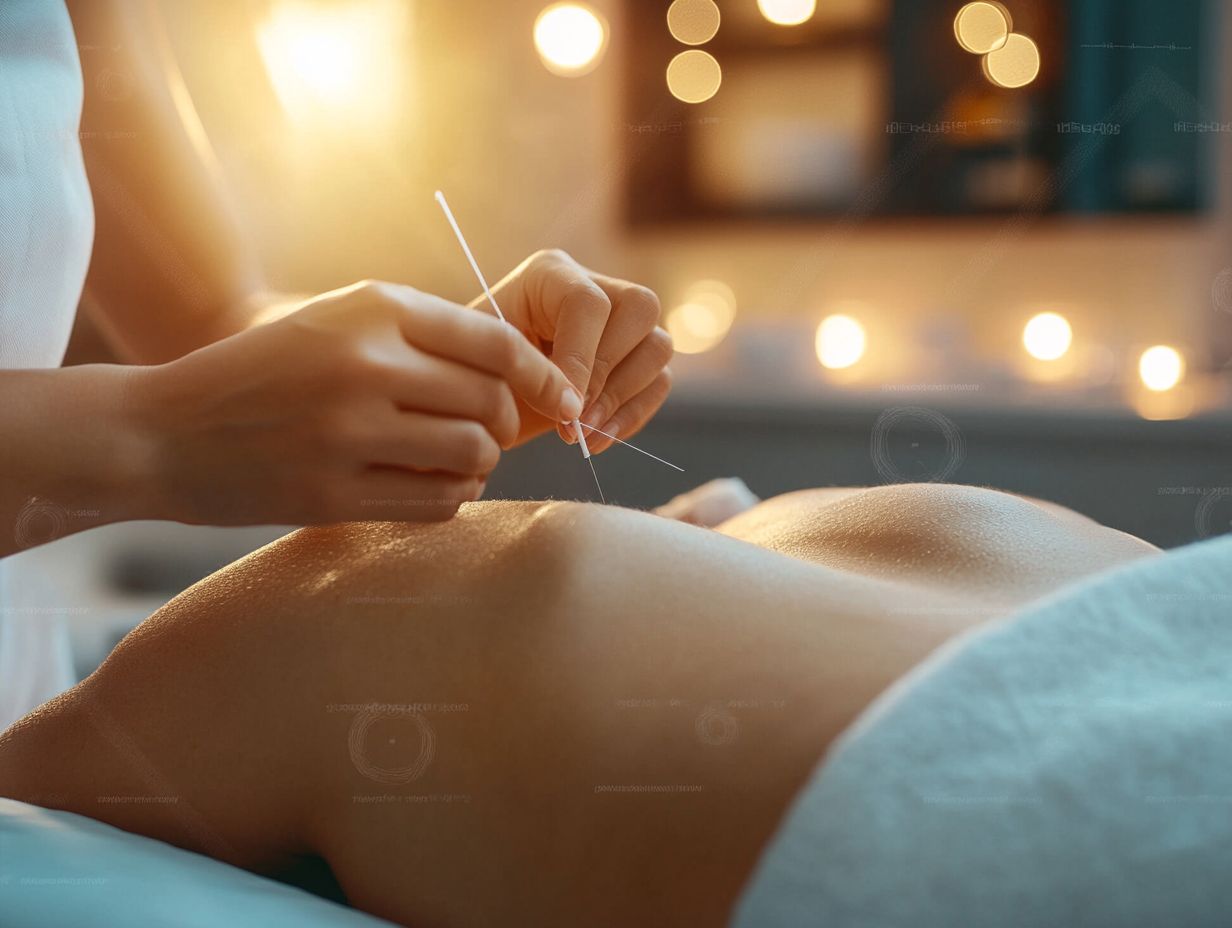
Mastering proper acupuncture needle techniques can transform your treatment into a powerful healing experience! These techniques ensure that needles are inserted at the correct depth and angle, minimizing injury risk while maximizing therapeutic benefits.
How does proper needle technique affect the patient’s experience?
Using proper needle techniques greatly improves the patient’s experience during treatment. Correctly inserted needles result in less discomfort, making patients feel relaxed and comfortable throughout the session.
What are the consequences of using improper needle techniques?
Improper needle techniques can have severe consequences for both the patient and the acupuncturist. They can lead to injuries such as bruising, bleeding, nerve damage, and infection. Additionally, ineffective treatments may cause frustration and disappointment for both the patient and practitioner.
Are there different needle techniques for different conditions?
Yes, various needle techniques are used in acupuncture. Each technique is tailored to the specific condition being treated, like back pain or migraines.
What should be considered when choosing an acupuncturist?
When selecting an acupuncturist, consider their training and experience. Make sure they are licensed and have a good understanding of needle techniques.
You can ask for referrals or read reviews from previous patients. This ensures you receive the best care!
Can I learn proper needle techniques for at-home acupuncture?
No, acupuncture is a complex practice that requires training and experience. Attempting at-home acupuncture can lead to serious injuries, so it should only be done by a licensed acupuncturist.

